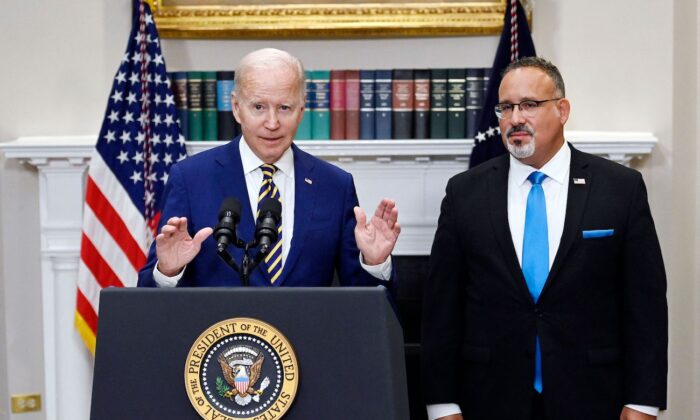By Mimi Nguyen Ly
The U.S. Department of Education announced that it estimates the Biden administration’s program to cancel student debt to cost $379 billion, or about $30 billion a year over the next 10 years.
The estimates are based on “highly uncertain assumptions about future economic conditions and participation rates,” the department noted.
The Biden administration’s plan is set to provide up to $10,000 in debt relief to borrowers who earn less than $125,000 per year, or $20,000 in debt relief to Pell Grant recipients who meet similar income standards. An application to receive the benefit is expected in early October.
“As a result of Student Debt Relief, millions of borrowers will no longer have to make repayments on their loans and millions more will be able to substantially reduce their repayments,” the Department of Education announced, adding it estimates that “over the next 10 years, the program will cost on average $30 billion annually.”
“The ten-year cost in terms of reduced cash flows into the government will be roughly $305 billion,” it noted.
“By law, the Department must also estimate the cost of student loan relief over the entire course of the program—in this case more than three decades—not just the next 10 years. That cost is adjusted to present-day dollar values, and then recorded fully in the current fiscal year. The Department’s estimate of this total cost in today’s dollars is $379 billion.”
The student loan cost estimate is based on the assumption that some 81 percent of eligible borrowers “will take the necessary steps to get relief.” According to the Department of Education, the assumption is “very uncertain, as other relief programs skew widely in terms of take-up rates.”
Approximately 43 million people are eligible for the relief, with 20 million being poised to have their entire debt wiped out, Biden administration officials have said.
The estimate is also based on other “highly uncertain assumptions,” it noted, citing examples including “interest rate projections, how quickly borrowers repay their loans, and wage growth projections.”
“Any variation in actual interest rates, wage growth rates, and other economic factors could lead to significant shifts in the costs of the student loan program and other Department programs,” the department noted.
“The Department’s Budget Office maintains a student loan model, which relies on these variables, to produce official estimates of the cost of federal student loan programs. Differences between the Department’s estimates and others are largely driven by differences in these base assumptions and assumptions about take-up rates.”
Other Estimates
The White House had previously estimated the cost of canceling student debt under Biden’s plan at about $24 billion a year over the next 10 years—about $240 billion for the decade. Meanwhile, the Congressional Budget Office, a federal agency, recently estimated the cost to be over $400 billion over the next 30 years.
The Committee for a Responsible Federal Budget, a non-profit public policy organization, had projected the cost to be $500 billion or more over the next decade.
Bharat Ramamurti, deputy director of the National Economic Council, said late August that the loan forgiveness program “is paid for and far more by the amount of deficit reduction that we’re already on track for this year.”
“We’re on track for $1.7 trillion in deficit reduction this year. That means, practically speaking, compared to the previous year, 1.7 trillion more dollars are coming into the Treasury than are going out. And we’re using a portion of that—a very small portion of it—to provide relief to middle-class families, consistent with the president’s plan,” he said, adding “we consider it fully paid for.”
Biden administration officials have touted that nearly 90 percent of relief dollars will be provided for borrowers who earn less than $75,000 per year, and no borrower or household in the top 5 percent of earners in the United States will have their loans canceled.
But lawmakers, both Republican and Democrat, as well as other experts have expressed concerns over the plan, saying it could raise the national debt and raise taxes amid soaring inflation across the country.
“They’re just looking for any story they can tell that lets them get away from the fact that they’re making the nation’s finances worse,” Marc Goldwein, senior policy director at the nonpartisan Committee for a Responsible Federal Budget, told Fox News. “This is going to worsen the deficit. There is no way to dance around it.”
Earlier in September, 22 governors called on Biden to withdraw the student debt relief plan.
The Department of Education’s cost estimation announcement comes on the same day that seven GOP-led states sued the Biden administration over the debt relief program, seeking to have it declared as unconstitutional and to block it from going into effect. Six states—Nebraska, Missouri, Arkansas, Iowa, Kansas, and South Carolina—filed their lawsuit in federal court in Missouri, while the state of Arizona filed its own legal challenge in a federal court in Arizona.






